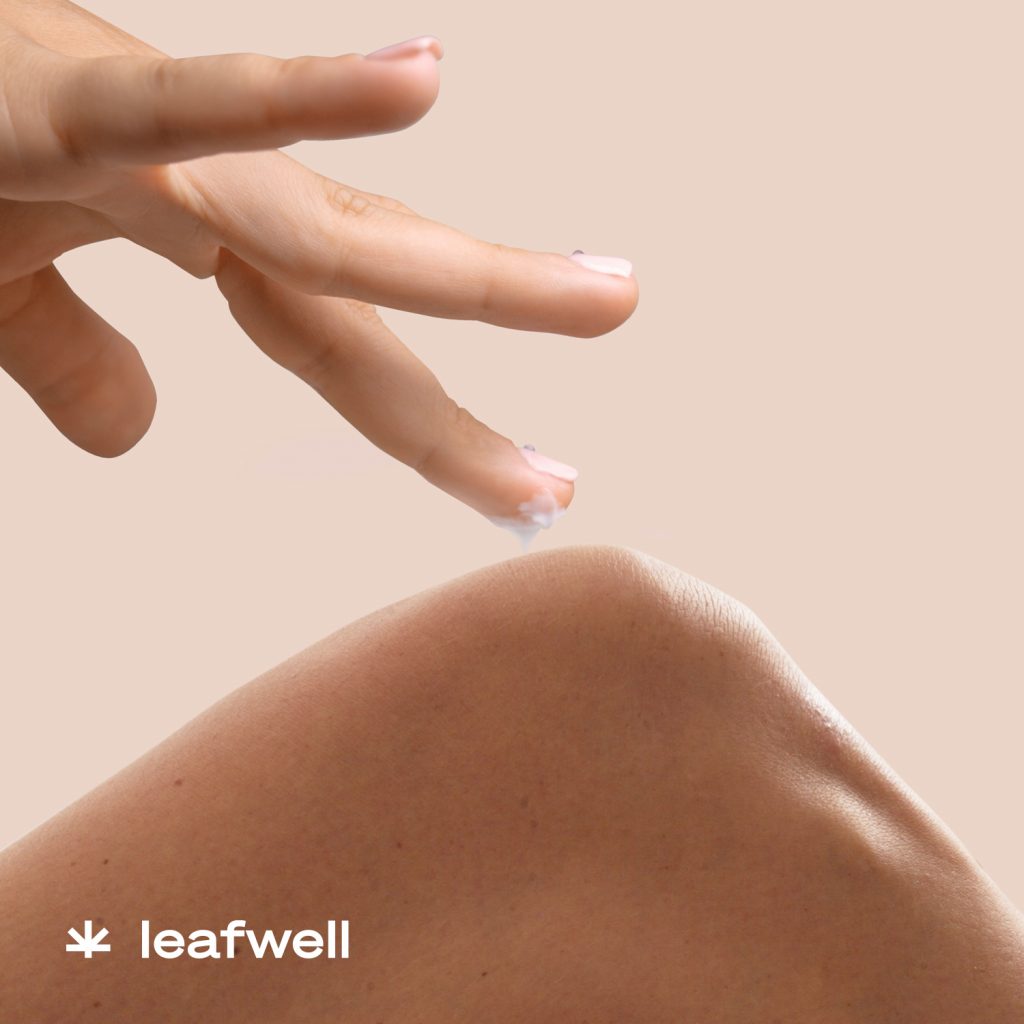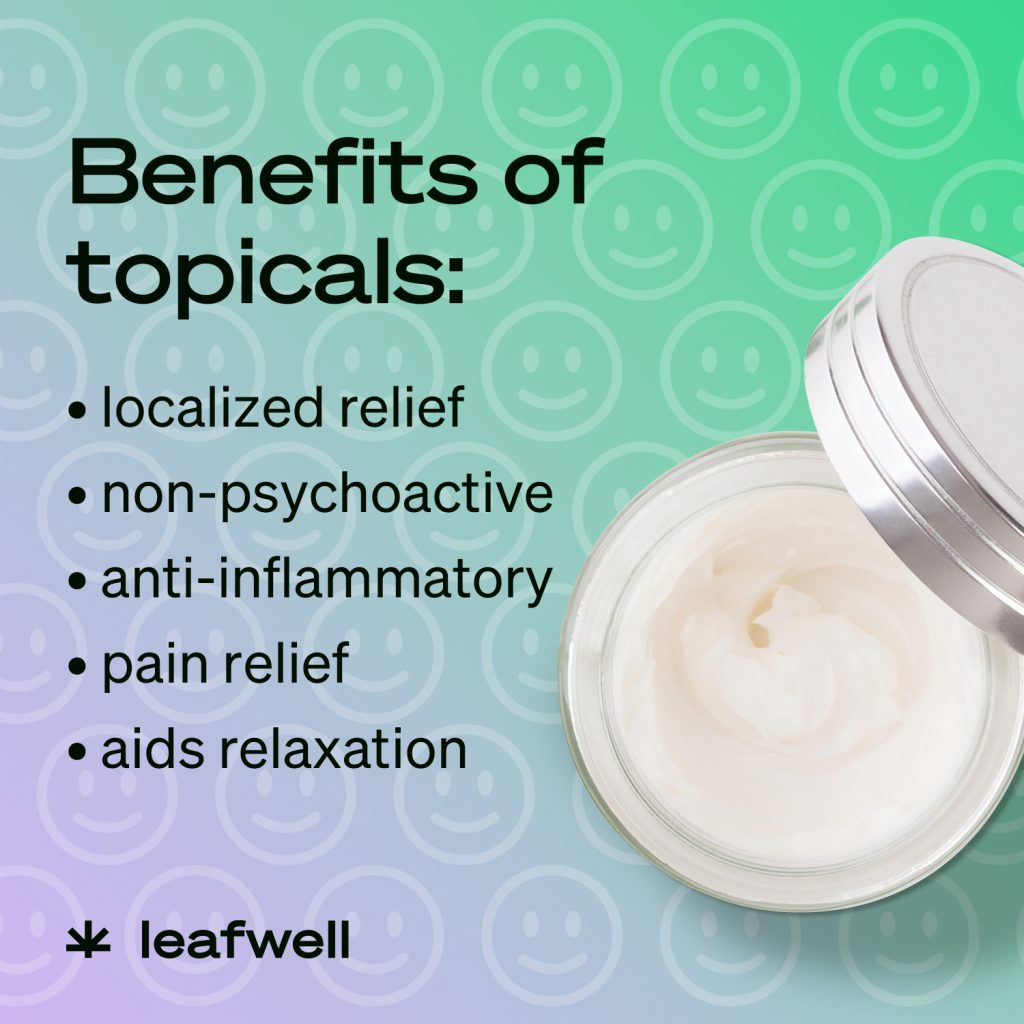
How to Dose Cannabis Topicals
Published on 12/13/21
Cannabis-infused topicals are creams, gels, foams, lotions, ointments, and salves applied to the skin for therapeutic effects. They can contain THC, CBD, minor cannabinoids like CBG, THCV, CBC, CBN, terpenes, and several other natural ingredients often found in high-quality topicals (e.g., camphor and arnica for pain, or lavender for relaxation).
As topicals are applied to the skin and do not reach the bloodstream, they are not psychoactive and can target specific, external body areas. Topicals can be helpful for neuropathic (nerve) pain relief, arthritic pain, skin cancers (e.g., melanomas), eczema, psoriasis, acne, burn treatment, post-exercise soreness & inflammation, dermatitis, and general skin care.
How Cannabis Topicals Work
Topicals are applied to the affected area of the skin for localized relief of pain, inflammation, and soreness. The skin absorbs topicals, and there are cannabinoid receptors in the skin, just as there are cannabinoid receptors throughout the body. Cannabinoids in the topical bind to these receptors on the skin, and these send instructions to the cells and immune system to slow down or stop inflammation. This makes topicals ideal for treating arthritis, nerve pain, and post-exercise or injury recovery. Topicals can also treat pain in joints. Cannabinoid-based topicals may be a helpful adjunct in the treatment of skin cancer as well.
Cannabidiol (CBD) can also help treat acne because it decreases sebum production in the skin, an oily substance that can cause spots. Tetrahydrocannabinol (THC), meanwhile, can increase sebum production at low doses and decrease sebum production in higher doses. CBD can help treat dry skin, while low amounts of THC can treat oily skin. Terpenes like pinene and beta-caryophyllene also have antibacterial and anti-inflammatory properties. This can make cannabinoid-based topicals ideal for conditions like acne, eczema, and psoriasis.

Health Benefits of Cannabis Topicals
One of the significant advantages of cannabis-infused topicals for many patients is that they can provide localized relief for skin and joint problems without any psychoactive effect. Topicals can relieve inflammation of the skin and joints, dry or oily skin, muscle stiffness and spasms, and chronic joint pain. Topicals can also help bust stress and aid relaxation due to the terpenes present in them, and many topicals also contain other compounds that can help rejuvenate the skin. Think vitamin E, aloe vera, argan oil, tea tree oil, menthol, and ceramides, amongst others.

Cannabis Topicals: How Much to Use
There is no typical dose for topicals, but medical cannabis patients should seek a cannabinoid content of at least 5 mg per ml. It is always wise to spot a topical on your elbow or knee before broader application to check for any allergic reactions.
But as there is no psychoactive effect (you may potentially feel some tingling or slight numbing of the skin due to other ingredients in the topical (e.g., arnica), you can apply topicals until the symptoms are relieved and reapply as necessary. Unlike with topical corticosteroids, there are no long-term side effects such as thinning skin, but more research is needed.
It is still wise to use topicals sparingly, to begin with, and see what your therapeutic dose is first. This can save you from any potential adverse reactions, on top of saving money. Most topicals will provide relief anything from 30 minutes to 3 hours (sometimes a little longer), depending on how much you have applied and how your body processes cannabinoids.
Topicals are usually absorbed by the skin within the hour, although thicker ones like balms may last longer. In general, onset is immediate, and effects last up to 3 hours. The only exception is transdermal patches.
Oils
One of the advantages of oil-based cannabis tinctures is that they have a variety of uses. Many think of tinctures as something to consume orally, but they can also be added to your favorite skin cream or topical and then applied to your skin.
Balms and Salves
Salves are a combination of herbal oils and beeswax. Balms are the same but have a higher beeswax content. Salves have a softer texture and are not as thick as balms, making them more accessible and quicker to absorb into the skin " great for skin conditions like eczema or psoriasis. Balms, meanwhile, are thicker and tend to stay on top of the skin, providing a more significant moisturizing effect.
Creams and Lotions
Creams are usually better for dry skin, as the thicker formulas lock in moisture and keep the skin hydrated. Lotions are better for oily skin, as the thinner formulas can help prevent clogged pores and acne breakouts.
Gels
Gels are a mixture of cellulose, water, and sometimes alcohol and fragrances, oil-free. We recommend avoiding alcohol-containing skin gels due to their drying effects. You may also want to be careful with added fragrances, as these can sometimes irritate the skin.
Oil-free cannabis products are ideal for extremely oily skin. Due to their cellulose and water content, they also absorb into the skin more rapidly than other topicals (within 30 minutes). They can be great for sunburns or sudden cases of inflammation. Gels can also be combined with lotions for more significant moisturizing effects on top of quicker absorption rates.
Sprays
Sprays are similar to lotions, but a thinner layer is usually applied to the skin because the lotion is released in bursts. Sprays can be quicker and easier to apply (especially to hard-to-reach areas) and help those who want to use lower doses, but others may find that a lotion, salve, balm, or gel is more beneficial to get the dosage they need.
Transdermal Patches
Even though transdermal patches are applied to the skin and can provide localized relief, they penetrate past the first several layers of skin and allow cannabinoids to enter the bloodstream. This means that if the patch contains THC, it will be psychoactive. This also means that transdermal patches are not technically topicals, as they provide systemic rather than local, topical absorption.
Transdermal patches also provide a steady release of cannabinoids into the bloodstream over time, and its effects can last an entire day, depending on the time release. Most patches last about 12 hours, but some may be designed for longer (sometimes up to three days!). Transdermal patches are ideal for treating arthritis, cancer, chronic pain, multiple sclerosis (MS), Parkinsons, seizures, and other chronic conditions or symptoms that may last a long time over the day.
The problem with transdermal patches is that they must be kept as clean and dry as possible to maintain efficacy, which can be challenging to do if you have a long-release patch that lasts longer than a day.
Tips for Using Cannabis Topicals
As cannabis topicals are non-psychoactive and dont have any significant adverse long-term effects (as far as we know), they are relatively safe and can be used just as you would any other well-made topical. With that being said, we still recommend the following:
- Spot test your topical on your elbows or knees for any adverse reactions " check for rashes, blistering, or other skin issues.
- Apply in thin layers and reapply after 15-30 minutes if symptoms havent improved " start low, go slow is true of topicals as well, as you can stop applying if any adverse reactions begin occurring.
- You can reapply topicals several times, but if you are still experiencing no benefits, you may need to find a different product. Homemade canna oil using coconut or olive oil mixed with your favorite topical can be helpful for this.
- Remember that cannabis is a plant that contains plenty of different terpenes, so in some rare instances may cause an allergic reaction.
- Apply to clean and dry skin.
- After testing, apply only to the affected areas.
- Unless advised otherwise by a medical professional, avoid applying to broken skin.
- Avoid applying plastic wraps and heat to the affected area after applying topicals, as this can potentially lead to adverse effects like burns or improper absorption of cannabinoids.
- As with any cannabis product, check the label for safety and potency testing and ensure its free of unwanted contaminants.
The Bottom Line on Cannabis Topicals
Topicals are one of the most approachable ways of utilizing cannabis but are looking to avoid its psychoactive effects. Topicals are an excellent method of ingestion for cannabis-naive patients looking for relief from skin or joint disorders.
Frequently Asked Questions About Cannabis-Infused Topicals
How long does it take for cannabis topicals to work? How fast do cannabis topicals work?
The onset of topicals is almost immediate, so you should notice any effects within the first few minutes, depending on the condition. For some conditions, like acne, it may take a few days to start seeing any significant differences, although inflammation can be reduced quite quickly. It is wise to wait about 15 " 30 minutes to reapply and only reapply as directed or necessary.
How long do cannabis topicals work?
The effects of cannabis-infused topicals generally last between 30 minutes and 3 hours, but on occasion longer, if it has been regularly reapplied and/or a lot of topical cream/salve/balm/lotion/gel has been applied.
Do CBD-only and hemp CBD topicals work?
As cannabis plants are a more ready source of cannabinoids than hemp plants, we generally recommend topicals using the cannabis plant and containing a wide range of cannabinoids and terpenes for the entourage effect.
Topical CBD products derived from cannabis plants with little THC may also be more effective than their hemp-based counterparts because potency tests are often more stringent for cannabis and may contain the milligrams (mg) of CBD listed on the packaging. There are many great topicals to choose from, and on occasion, there are some more widely legal and available hemp-based ones!
